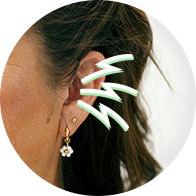
Affordable earwax removal services by Hearing Professionals
Get professional earwax removal at select HearingLife clinics across Canada. Safe, quick, and budget-friendly care from trusted hearing care professionals.
What is earwax? Symptoms Removal services Request an earwax removal Book a FREE consultation
Monday - Friday: 8am to 8pm EST
Understanding Earwax and Earwax Blockage
What is Earwax?
Earwax, also known as cerumen, is a natural substance produced by glands in the ear canal. It serves several important functions:
Protection: Earwax traps dust, debris, and microorganisms, preventing them from reaching the delicate inner ear.
Lubrication: It keeps the ear canal moist, preventing dryness and irritation.
Antimicrobial Properties: Earwax contains substances that help fight infections and prevent the growth of bacteria and fungi.
What is earwax removal?
Earwax removal is a process aimed at eliminating excess earwax that has accumulated in the ear canal. This procedure is essential when earwax builds up to a level that causes symptoms or obstructs the ear canal, leading to discomfort and hearing issues.
What are the symptoms of earwax blockage?
Earwax blockage, or cerumen impaction, can present a range of symptoms that often develop gradually, making them easy to overlook. Recognizing these signs is crucial as addressing earwax buildup can significantly improve your hearing and overall ear health.
Common symptoms include:
- Earache: Discomfort or pain in the ear, which may range from mild to severe.
- Feedback/squealing from hearing aid while being worn in affected ear.
- Ringing or Noises in the Ear (Tinnitus): Persistent sounds such as ringing, buzzing, or humming in the ear.
- Decreased Hearing: Gradual or sudden reduction in hearing ability, affecting both ears or just one.
- Feeling of Fullness: Sensation of the ear being plugged or full, affecting hearing clarity.
- Coughing: In some cases, a persistent cough may occur.
- Dizziness: Feeling lightheaded, unsteady, or experiencing vertigo.
What to do:
If you experience any of these symptoms, it may indicate a potential earwax blockage. At select HearingLife clinics, our experienced professionals can safely examine your ears and provide gentle, effective removal of excess earwax using specialized techniques. Removing the blockage typically alleviates these symptoms and restores normal hearing function.
Ignoring earwax buildup can lead to further complications, so it's essential to seek professional advice if symptoms persist after attempting home remedies. Our team is dedicated to ensuring your ear health and overall well-being.
How are earwax blockages removed?
Earwax is a naturally occurring substance in the ear canal. It’s actually good for your ears, helping to keep the skin healthy and prevent infection at the same time. Some people suffer from excessive earwax, and this can be managed by the use of drops or irrigation. Wax can cause hearing loss, and it can interfere with a hearing test or the use of a hearing aid.
How much is an earwax removal?
Our earwax removal fee is $54 per ear. Our wax consultation is free and includes a discussion, assessment by screening, video otoscopy, a general ear health check-up, and any advice needed.
How to Safely Clean Blocked Ears: Tips for Removing Earwax
Blocked ears due to earwax? Our Chief Audiologist, Dr Jillian Price shows you how to safely and effectively clean your ears at home. Learn the best techniques and tips to remove earwax and maintain your hearing health. Remember, taking care of your ears is essential for your overall well-being.
#DidYouKnow?
Earwax plays an important role in keeping your ears healthy, but there are a few things most of us might not know.
- Home remedies for earwax removal, like using cotton swabs, can actually damage your ears by pushing wax deeper and increasing the risk of blockages or injury. Professional earwax removal is safer and more effective for maintaining healthy ears.
- The colour of your earwax can reveal important information about your ear health.
- Earwax has antibacterial and antifungal properties that help protect your ears from infections.
- Earwax removal at home using liquids like hydrogen peroxide or olive oil drops should be done with caution and guidance from a healthcare provider.
- Excessive earwax buildup can lead to symptoms like hearing loss, tinnitus, and a feeling of fullness in the ear.


Request an earwax removal today
Earwax removal services are offered at select HearingLife clinics and the method of extraction utilized will be determined by the hearing professional after assessing the client and reviewing their history.
HearingLife earwax removal services
In most cases, earwax works its way out on its own, and there is no need to remove it. However, if earwax is blocking your ear canal and causing hearing loss, it may require removal using one of the following methods:

1. Manual
Using specialized instruments, earwax can be manually removed from the outer portion of the ear canal. In cases where the ear wax is particularly dense and deep, it can be helpful to manually remove it. However, manual eradication is frequently combined with other, more sophisticated methods.

2. Ear Irrigation
Ear irrigation is a procedure where water (at body temperature) is injected into the ear by the irrigator, which controls the water pressure, to ensure that the ear cannot be damaged. Under the gentle force of the water, the earwax is softened and dislodged, and the wax is carried out of the ear.
Earwax removal methods we recommend avoiding:
FAQ About earwax removal
6 common signs of hearing loss
Changes in your hearing may be a sign of earwax build-up, but they can also be a sign of hearing loss. Study the six common signs of hearing loss to learn what to look out for:
Terms and conditions
Written, informed consent is required. The Consent to Treatment form must be signed, and this is valid for one year. HearingLife Canada adopts all practice standards, guidelines and regulatory requirements established by the appropriate professional associations and regulatory colleges as our minimum practice standard. Audiologists and hearing instrument practitioners should refer to their respective provincial regulatory bodies for details about full practice guidelines and regulatory requirements.










